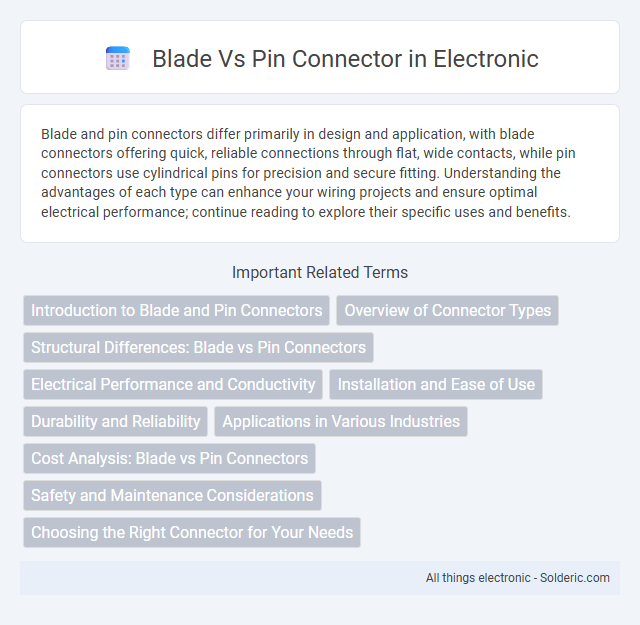Blade and pin connectors differ primarily in design and application, with blade connectors offering quick, reliable connections through flat, wide contacts, while pin connectors use cylindrical pins for precision and secure fitting. Understanding the advantages of each type can enhance your wiring projects and ensure optimal electrical performance; continue reading to explore their specific uses and benefits.
Comparison Table
| Feature | Blade Connector | Pin Connector |
|---|---|---|
| Design | Flat, rectangular metal blade | Cylindrical metal pin |
| Connection Type | Slide-in, quick connect | Insert into socket or header |
| Common Uses | Automotive wiring, appliances | PCB connections, electronics |
| Current Capacity | Typically up to 30A | Varies; usually up to 5A for small pins |
| Durability | Good mechanical strength | Moderate mechanical strength |
| Ease of Replacement | Easy to disconnect and replace | Requires proper socket alignment |
| Size | Generally larger footprint | Compact, suits tight spaces |
| Contact Stability | Stable under vibration | May loosen under vibration |
Introduction to Blade and Pin Connectors
Blade connectors feature flat, rectangular metal terminals designed for quick and secure slide-in connections, commonly used in automotive and electrical applications. Pin connectors consist of cylindrical metal pins that fit into corresponding sockets, offering precise alignment and reliable contact, ideal for electronic devices and circuit boards. Understanding your equipment's requirements will help determine whether blade or pin connectors provide the optimal balance of durability and ease of use.
Overview of Connector Types
Blade connectors feature flat, rectangular metal contacts designed for quick and secure push-in connections, commonly used in automotive and household wiring. Pin connectors utilize cylindrical metal pins that fit into corresponding sockets, offering precise alignment and reliable contact in electronic and industrial applications. Both connector types facilitate efficient electrical connectivity, with blade connectors excelling in ease of use and pin connectors providing enhanced stability in high-vibration environments.
Structural Differences: Blade vs Pin Connectors
Blade connectors feature flat, rectangular metal contacts designed for quick slide-in connections, while pin connectors use cylindrical or tapered pins inserted into corresponding sockets for secure alignment. Blade connectors provide ease of installation and removal in low-vibration applications, whereas pin connectors ensure higher stability and reliable contact in demanding electrical environments. The structural design of blade connectors allows for broader contact surfaces, contrasting with the precise fit and mechanical locking found in pin connector assemblies.
Electrical Performance and Conductivity
Blade connectors exhibit lower electrical resistance due to their larger contact surface area, enhancing conductivity in high-current applications. Pin connectors, while offering precise alignment and ease of mating, may experience increased contact resistance if not properly secured, affecting overall electrical efficiency. Optimizing connector material, such as using copper or silver plating, significantly improves conductivity and ensures stable electrical performance in both blade and pin configurations.
Installation and Ease of Use
Blade connectors offer quick and straightforward installation by simply sliding onto the terminal, making them highly user-friendly for rapid electrical connections. Pin connectors require precise alignment and insertion into a matching socket, which can be slightly more time-consuming but ensures a secure fit. Your choice depends on whether you prioritize speed and convenience or a firm, reliable connection.
Durability and Reliability
Blade connectors, made of high-quality metal alloys, offer superior durability under repeated mechanical stress and exposure to corrosive environments. Pin connectors provide reliable electrical contact in low-vibration applications but may suffer from loosening or wear in harsh conditions. The choice between blade and pin connectors hinges on the specific durability requirements and environmental factors impacting long-term reliability.
Applications in Various Industries
Blade and pin connectors serve critical roles across automotive, aerospace, and industrial machinery sectors due to their reliable electrical conductivity and ease of assembly. Blade connectors are favored in automotive wiring harnesses for quick, secure connections, while pin connectors are prevalent in aerospace systems demanding high precision and durability under extreme conditions. Your choice between these connectors impacts maintenance efficiency and system performance in manufacturing, robotics, and consumer electronics applications.
Cost Analysis: Blade vs Pin Connectors
Blade connectors generally offer lower manufacturing costs due to simpler stamping and forming processes, reducing material waste and assembly time. Pin connectors, while often more expensive upfront, provide greater durability and reliability in harsh environments, which can lower total lifecycle costs in industrial applications. Evaluating cost-effectiveness depends on quantity, application requirements, and maintenance considerations, with blade connectors favored for high-volume, cost-sensitive projects and pin connectors preferred for long-term performance.
Safety and Maintenance Considerations
Blade connectors offer safer handling due to their exposed metal edges, increasing the risk of accidental contact and short circuits, while pin connectors typically provide more secure connections with reduced exposure. Maintenance of blade connectors requires frequent inspection for corrosion or bending, which can compromise electrical conductivity, whereas pin connectors benefit from their enclosed design, reducing wear and easing cleaning tasks. Selecting the right connector impacts your electrical system's reliability and safety, so understanding these maintenance demands is crucial for optimal performance.
Choosing the Right Connector for Your Needs
Selecting the appropriate connector between blade and pin types depends on application-specific requirements such as current capacity, ease of installation, and mechanical durability. Blade connectors provide robust, high-current connections ideal for automotive and industrial uses, while pin connectors offer precise, secure fits suited for low-current or signal applications in electronics. Evaluating factors like environmental exposure, mating cycles, and space constraints ensures optimal performance and longevity in your electrical systems.
Blade vs Pin connector Infographic

 solderic.com
solderic.com